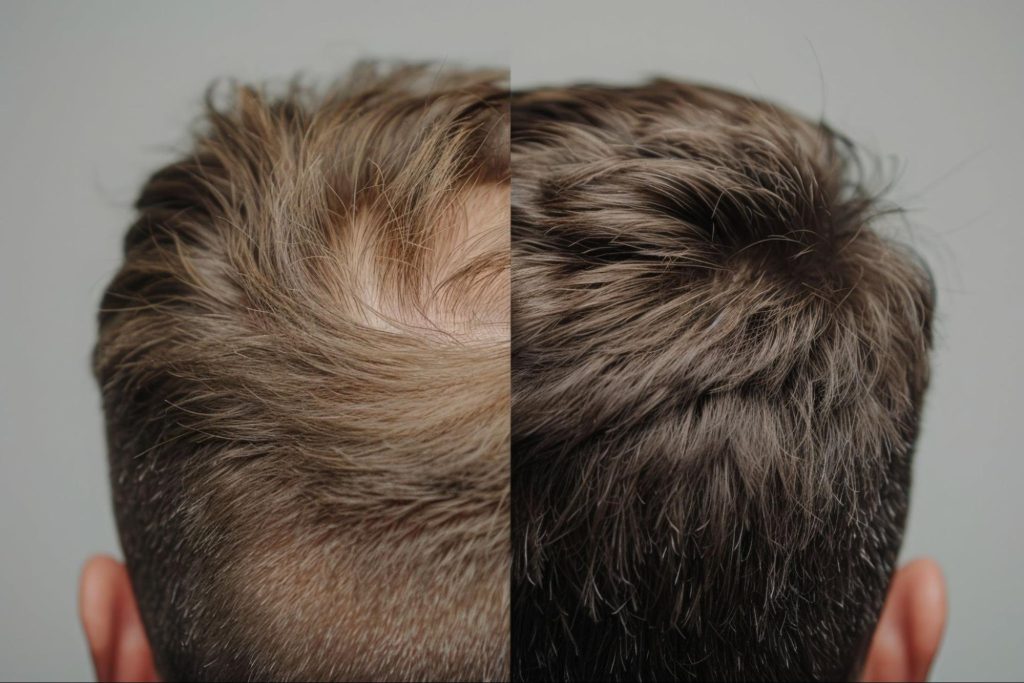Hair restoration is a significant choice, and with the range of treatments available today, picking the right option can feel overwhelming. Whether you are dealing with early-stage thinning, balding, or overall hair loss, finding the ideal solution means selecting a treatment that suits your needs and goals.
But before making a decision, it is important to understand the causes behind your hair loss and the different treatments available, so you can confidently move forward with a plan that will deliver the best possible results.
Read here to learn more about the interventions that can lead you to the right hair restoration treatment for your needs.
Why People Seek Hair Restoration Treatments
Hair loss is a natural part of aging, but that doesn’t mean it is easy to deal with. For many, it can be a distressing experience that leads to a loss of confidence and self-esteem. Both men and women suffer from hair thinning, pattern baldness, or even medical conditions that lead to hair loss.
Hair restoration is often seen as a transformative procedure that not only restores hair but also restores a person’s overall sense of well-being. Here are the possible reasons that can lead to hair loss:
- Aging. One of the most common reasons for hair loss is aging. As we get older, the hair naturally becomes thinner and weaker. For many, the hair starts to fall out or recede, especially around the temples and crown.
- Genetics. Hereditary hair loss, or androgenetic alopecia, is the most prevalent cause of hair loss in both men and women. If you have family members who have dealt with hair loss, there’s a high likelihood you may experience it too.
- Medical Conditions. Conditions like alopecia areata, an autoimmune disease, or certain hormonal imbalances, such as thyroid disorders, can lead to hair loss.
- Lifestyle Factors. Poor diet, stress, and lack of sleep can significantly impact hair health. These factors can speed up the hair loss process or make it more pronounced.
At New Beauty Company Aesthetics, we understand the emotional toll hair loss can take on a person’s life, and that’s why we offer advanced hair restoration options that provide natural-looking results.
Factors to Consider When Choosing a Hair Restoration Treatment
When deciding on a hair restoration treatment, several factors should come into play. It is essential to assess the following considerations before proceeding with a treatment plan to achieve long-term success and satisfaction.
Type of Hair Loss
Understanding your hair loss type is important to finding the right treatment. Hair loss can be temporary due to stress or illness, or permanent, like androgenetic alopecia. If the loss is localized to one area (patchy), treatments like PRP or hair transplants may work best.
Diffuse thinning across the scalp may require topical or oral medications. Recognizing the nature of your hair loss ensures you get a targeted treatment that addresses the root cause effectively.
Desired Results
Clarifying your goals will help shape your treatment plan. Do you want to restore a full head of hair, or simply thicken thinning areas? If you are aiming for permanent results, treatments like FUE hair transplants might be your best bet.
Alternatively, if you are looking for a less invasive solution that requires less commitment, non-surgical treatments such as KeraLase™ or supplements like Nutrafol® might suffice. Knowing your long-term vision helps avoid frustration and sets realistic expectations.
Budget
The cost of hair restoration treatments varies widely depending on the type of procedure. Non-invasive treatments like supplements, low-level laser therapy, and topical solutions can be more budget-friendly but may require long-term use.
On the other hand, treatments like FUE hair transplants or PRP injections offer long-lasting results but come at a higher cost. It is essential to align your financial expectations with the level of commitment you are willing to make.
Treatment Commitment
Some treatments demand significant dedication, especially non-surgical ones that may require multiple sessions over several months. For instance, PRP therapy or laser treatments need consistent visits, whereas FUE hair transplants are typically a one-time surgical procedure followed by a recovery period. You should assess how much time you’re willing to spend on treatments and if you’re ready for the long-term upkeep certain procedures may require.
Recovery Time
Different treatments have varied recovery timelines. Minimally invasive procedures like laser therapy require little to no downtime, allowing you to continue your daily activities immediately after treatment.
On the other hand, surgical solutions like hair transplants might need you to take a few days or even weeks off for optimal healing. When deciding, consider how much downtime you can accommodate within your lifestyle.
These factors not only help you find the right treatment but guarantee that you are making a well-informed decision about the method that best aligns with your goals, budget, and lifestyle.
Popular Hair Restoration Treatments
There are a variety of hair restoration treatments available, ranging from surgical to non-invasive options. Below, we’ll explore some of the most effective treatments used for hair loss prevention:
- Hair Transplant (Follicular Unit Extraction – FUE). FUE is a surgical procedure where individual hair follicles are harvested from a donor area (usually the back of the head) and implanted into areas where the hair is thinning or balding. FUE is popular for its natural-looking results and minimal scarring, making it ideal for those looking for a more permanent solution.
- Scalp Micropigmentation (SMP). Scalp micropigmentation is a non-surgical treatment that involves tattooing small dots on the scalp to mimic the appearance of hair follicles. This treatment is ideal for people who want to add the appearance of fullness or cover bald spots without undergoing surgery.
- Low-Level Laser Therapy (LLLT). LLLT uses red light to stimulate hair follicles and encourage new hair growth. This non-invasive treatment is perfect for those experiencing thinning hair or the early stages of hair loss.
- Platelet-Rich Plasma (PRP) Therapy. PRP therapy uses your own blood, processed to concentrate the platelets, which are then injected into the scalp. Platelets are rich in growth factors that stimulate hair follicles to grow new hair. It is an effective treatment for both men and women.
- Medications and Topical Solutions. FDA-approved medications like minoxidil (Rogaine) and finasteride (Propecia) are often used to slow down hair loss and promote new growth. These are typically used for mild to moderate hair loss and require ongoing use.
Non-Invasive Solutions
At New Beauty Company Aesthetics, we specialize in non-surgical treatments that offer excellent results without the need for invasive procedures:
KeraLase™
KeraLase™ is an innovative hair restoration treatment designed for all skin types and backed by FDA clearance. It combines dual-action technology, utilizing the Lutronic LaseMD Ultra® laser along with KeraFactorMD® Topical Growth Factors, to stimulate and invigorate hair follicles. This process promotes the development of stronger, thicker hair.
One of the standout features of KeraLase™ is its laser microchanneling technique, which enhances the skin’s ability to absorb growth factors by 5 to 7 times, maximizing the treatment’s impact. This method ensures the treatment targets the deeper layers of the scalp, encouraging optimal hair regrowth.
DHT Blockers (Propecia)
For men experiencing male pattern baldness, one of the primary factors behind hair loss is the hormone dihydrotestosterone (DHT). DHT can shrink hair follicles, leading to thinner hair and eventual hair loss. To counteract this, we may prescribe Propecia (finasteride), an FDA-approved oral medication that effectively blocks the production of DHT.
By reducing DHT levels in the scalp, Propecia works to prevent further hair loss while promoting the regrowth of healthier, stronger hair. Clinical studies have shown that Propecia not only helps slow down hair loss but also encourages regrowth in areas where hair thinning is most prominent, such as the crown and the top of the scalp.
Propecia is particularly effective when used as part of a comprehensive hair restoration plan. It’s a long-term solution for men looking to maintain their existing hair and stimulate new growth, especially when combined with other treatments like KeraLase™.
Recommended Supplement: Nutrafol®
As part of your hair restoration plan, we recommend Nutrafol®, a supplement known for its natural, physician-formulated ingredients designed to support hair health from within. Nutrafol® is the #1 dermatologist-recommended hair growth supplement brand and is backed by clinical studies that show significant improvements in hair growth and thickness.
Nutrafol® offers tailored formulas that address specific hair needs based on various life stages, including stress, hormonal changes, and menopause. This customization allows both men and women to benefit from Nutrafol®’s ability to target the root causes of hair thinning and support overall hair wellness.

Your Path to Fuller, Healthier Hair Starts Here
Choosing the right hair restoration treatment doesn’t have to be overwhelming. By understanding the root cause of your hair loss, aligning with your desired results, and considering factors like budget, treatment commitment, and recovery time, you can find a personalized solution that works for you.
Here at New Beauty Company Aesthetics in St. Johns, FL, we’re here to guide you through the process. Whether you choose KeraLase™, DHT blockers like Propecia, or enhance your treatment with Nutrafol®, investing in the right care is your first step to reclaiming confidence and restoring your hair.
Call us now at (904) 767-3969 to schedule your appointment today! Let us help you regain your confidence with natural-looking, healthy hair!


